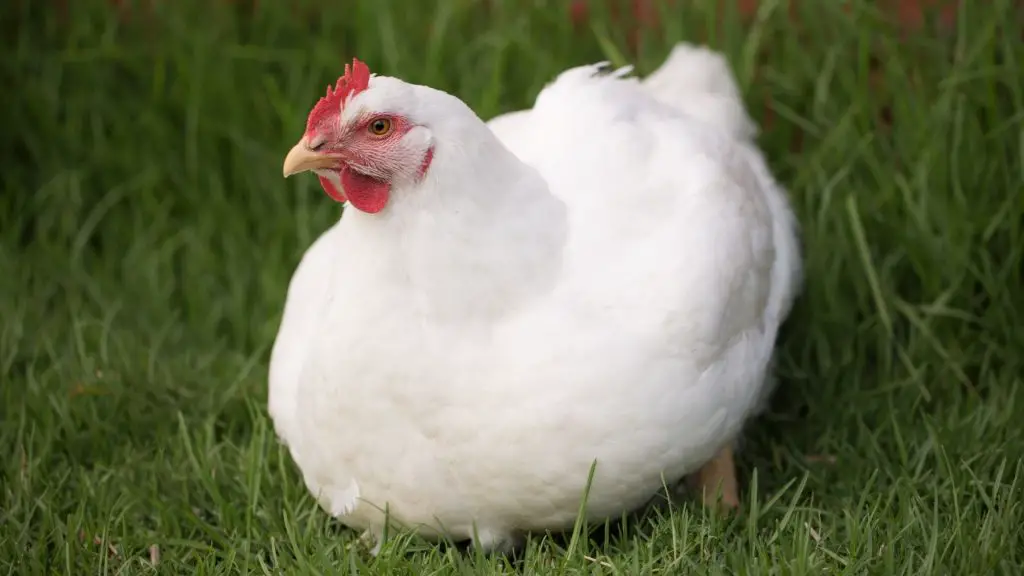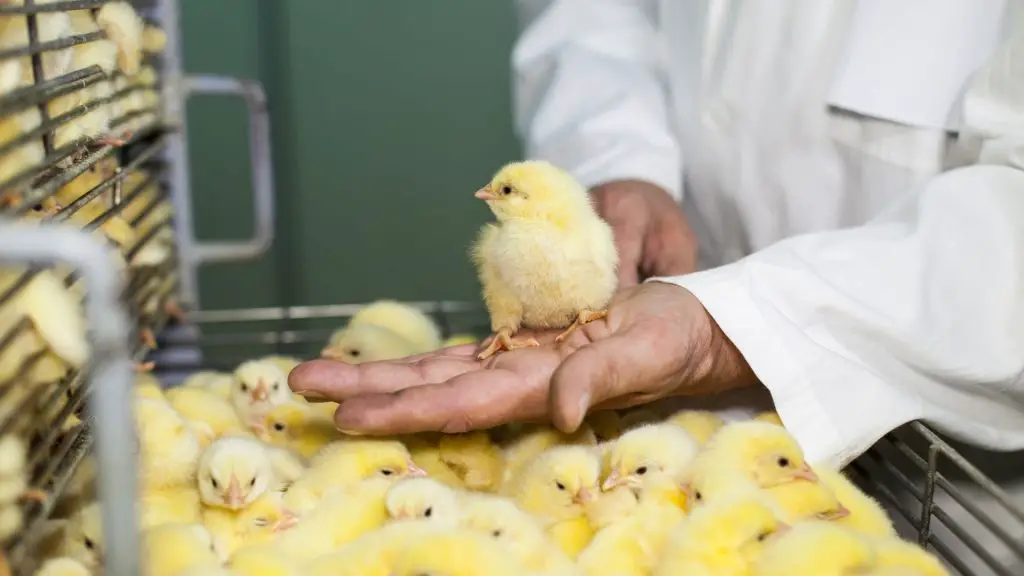Chicken is generally high-quality protein with relatively low-fat content, making it one of the most widely consumed foods in the world. Modern management practices that include advancement in nutrition, disease control, and breeding techniques make chickens have a low selling price, increasing their demand worldwide.
Here’s how you can start a broiler chicken farm:
1. Apply for a license and registration.
2. Select a good location for your chicken farm.
3. Choose the right breed of chicken.
4. Construct a poultry house.
5. Invest in quality equipment.
6. Hire people to help you with the operation.
7. Create a safe and hygienic environment.
8. Create a business plan.
This article will cover everything you need to know about raising broiler chickens, whether on a small scale in your backyard or on a large scale. The topics covered will include the breeds of broilers, what you need to start a chicken farm, how much it costs, and how to invest in a chicken farm.
What Is a Broiler Chicken?

The popularity of broiler chickens makes them one of the easiest breeds for beginners looking to start a chicken farm. However, some people still don’t know what a broiler chicken is or how it looks.
Broiler chicken is chicken produced for meat production. That also means it’s bred to have a rapid growth rate, often attaining market or consumer size in 5–7 weeks. However, there are slow-growing breeds that reach the market or consumer size in 12–16 weeks.
Broiler Chicken Breeds
Broilers are genetically enhanced to promote fast growth, making them susceptible to poultry diseases. Several breeds of broiler chickens are available, and you must select a suitable species readily available in your area.
Here’s a list of some of the most popular broiler breeds available:
1. Cornish Cross
The Cornish cross is the most popular breed of broiler chickens. When you buy chicken at the grocery store, the chances are that you’ll pick up a Cornish cross. They’re the fastest-growing of all broiler chickens with reasonable feed conversion rates, making them a cost-effective investment.
Male Cornish crosses weigh about 5 lb (2.27 kg) at 6 weeks. The female Cornish cross grows slower, weighing about 2.5 lb (1.13 kg) at 5 weeks.
Cornish crosses are vulnerable to health problems and are more suitable for indoor production. It’s best to harvest them at 6–8 weeks because growing them for longer will present several issues like lameness, heart problems, and even sudden death.
2. Red Broilers
Red broilers (or label rouge in France) are a slower-growing breed than Cornish crosses. It takes twice as long for the red broilers to reach market size when compared to Cornish crosses. Male red broilers weigh about 7 lb (3.18 kg) at 12 weeks, while females weigh about 5 lb (2.27 kg) within the same time frame.
If you’re looking for a breed suitable for outdoor production, red broilers are a perfect choice. They’re more stress-tolerant and resistant to diseases.
3. Rosambro Broilers
The Rosambro is a medium-growth broiler chicken. It’s profitable because it packs the same benefits as the red broilers, such as resistance to diseases while growing faster. Rosambro broilers often reach a market size between 8–10 weeks.
How to Start Your First Broiler Chicken Farm?

Starting a chicken farm requires thorough knowledge and understanding of all requirements, whether small or large scale. Fortunately, running a chicken farm is pretty straightforward.
The following section will explain these requirements, which are essential for starting your broiler chicken farm business.
1. Apply for a License and Registration
Before starting a chicken farm, you may have to consider permits, licenses, and regulations. These regulations may be at the national level, state level, or even specific to your county. It’s advisable to check with your state department of agriculture for more information.
2. Select a Good Location for Your Chicken Farm
When it comes to chicken farming, choosing a good location is key to a successful farm. The site should be calm and quiet, with easy access to water, electricity, and transportation. A good site should be in an elevated area, free from waterlogging and away from residential or industrial areas.
However, if you raise a few birds, you can situate the farm at the corner of your house and ensure it’s quiet, free of odor, and safe from predators.
3. Choose the Right Breed of Chicken
Chicken breeds differ in growth rate, temperament, susceptibility to diseases, housing needs, etc. It’s essential to choose a breed that suits your needs and is readily available in your location, especially when it comes to climate tolerance.
4. Construct a Poultry House
Chickens are fragile, and it’s essential to raise them in a well-constructed house for a successful chicken farm. For a small-scale chicken farm, a simple building with basic facilities should suffice. On the other hand, consulting with experts specializing in poultry houses for a large commercial farm is advisable.
No matter the size of your farm, you must do the following to create a good poultry house:
- Allocate at least 1–2 square feet (0.3–0.6 square meter) of space per bird.
- Ensure adequate ventilation to allow for fresh air to flow freely.
- The house should be free of any draft wind and dampness.
- Don’t forget to provide sufficient lighting in the house.
- Construct the house such that the longer side is in the east-west direction to prevent direct sunlight over the birds.
- Include plans for waste disposal so that it doesn’t pose an environmental risk.
- Consider the growth potential of the chicken farm and construct the house with the possibility of future expansion in mind.
5. Invest in Quality Equipment
Running a successful chicken farm requires the following equipment:
- Brooders for heat
- Feeders
- Waterers
- Lighting equipment
- Ventilation system
6. Hire People to Help You With the Operation
You may decide to hire a workforce depending on the size of your chicken farm. For a small farm of 500 birds or less, you can run the farm alone. However, as your farm increases in size, you’ll have to consider employing other people.
7. Create a Safe and Hygienic Environment
Providing an enabling environment for poultry diseases to thrive will wreak havoc on your farm. Viral diseases are a significant threat, and preventing them is key to the success of the farm. Luckily, proper sanitation and hygiene will reduce the occurrence of viral diseases.
8. Create a Business Plan
A business plan is a guide you can use to pre-plan the trajectory of your business. It should have details of everything you’ll need to start a chicken farm, laying out all the goals you need to achieve and helping you to check your progress.
It doesn’t just stop there; you can use your business plan to secure financing from government or non-governmental organizations.
How Much Money to Start a Chicken Farm?

Before starting a chicken farm, there’s a need to calculate possible costs and match them with your budget. It’s important to note that the cost of starting may largely depend on the size you want.
$5,000–$25,000 may be enough to start running a small to medium-scale chicken farm. On the other hand, a large-scale chicken farm will need at least $750,000 to kick off farming activities.
Of course, many factors may influence the total amount of money you need to start a chicken farm. The factors are explained below:
- Land. Before starting a chicken farm, you’d need to buy a suitable piece of land, and it’s easy to find a large plot of land at a relatively low price outside residential areas.
- Cost of construction. The cost of constructing a chicken house varies with the type of housing you need. Having free-range chickens is much cheaper than having intensive standard housing that requires expert builders. You should also consider the cost of other buildings, such as storage rooms for equipment or a farmhouse for farm laborers.
- Chick breeds. Choosing the right breed of chicks is economically beneficial. Buying day-old chicks is cheaper than buying grown chickens. It’s best to buy day-old chickens from reputable hatcheries.
- Poultry equipment. The cost of buying equipment depends on the nature of poultry farming you’re engaging in and your farm’s size. You may decide to hatch your chickens to control the process, costing you more on hatching equipment. Or you may choose to process the meat yourself or produce your feed which will drastically increase your equipment cost.
- Vaccination. Poultry birds are fragile, and vaccinating them ensures they grow optimally. Don’t skimp on your chickens’ vaccination needs.
- Feeding. Feeding is perhaps the singular most significant contributor to the overall cost of running a chicken farm. High-quality feed is vital to ensure optimal growth, and you can’t afford to skim on this. The chicks have different feed requirements according to their age (starter, grower, and finisher).
- Labor cost. If your farm is somewhat large, you’ll have to employ extra hands. Therefore, you have to make provisions for labor costs for at least the first 3 months before you start raking in profits. The cost of labor will also depend on labor laws in your area.
- Disease management. Chickens are susceptible to a few diseases, and control and prevention plans should always be in place. You have to factor in the cost of medicines in the overall total cost of starting a chicken farm.
- Other costs. These costs include but aren’t limited to marketing, security, insurance, transportation, electricity, etc.
How to Invest in Chicken Farming?

The United States is the biggest producer and consumer of broiler meat in the world. As the demand for broiler meat increases, there is a need for more poultry farms to meet demand. While starting a chicken farm is one of the most profitable ventures, investing comes with risk.
You can invest in a chicken farm by applying for government grants, securing a bank loan, considering equity financing, using personal savings, or getting loans from your friends and families. Investing in a broiler chicken farm has risks, so weigh your options carefully and realistically.
Here’s how to invest in chicken farming:
1. Apply for Government Grants
The United States government periodically develops programs that support farmers at federal, state, and local levels. The government also collaborates with research institutes and non-governmental organizations to provide grants for poultry farmers.
2. Secure a Bank Loan
Getting a loan from the bank is another option when it comes to investing in a chicken farm. Before taking out a bank loan, consider the farm’s profitability. The risk of taking out a loan is that defaulting on that loan can lead to you closing the farm. Chicken farming is a highly profitable but risky venture.
However, with good management practices, you can mitigate the risk involved.
3. Consider Equity Financing
Equity financing is an alternative to taking out a loan. The farmer can collaborate with a financier to get the capital in exchange for a stake in the farm. This will allow the farmer to share any profit or losses with the investor rather than carry the burden alone.
4. Use Personal Savings or Loans From Close Kins
Another way to invest in a chicken farm is through personal savings or loans from family and friends. This method is often suitable on a small or medium scale, and it’s not as capital intensive as commercial chicken farming requires.
Care and Management Practices for Chicken Farming
Increasing efficiency and productivity to maximize returns on investment is the main aim of running a chicken farm. Carrying out sound management practices will guarantee a good return on investment.
Steps for Welcoming Your Broiler Chicks

Step 1: Wash and disinfect every chicken house area thoroughly, including doors, windows, walls, etc.
Step 2: Wash and disinfect every poultry equipment such as feeders and waterers thoroughly.
Step 3: Pour out dry litter, preferably pine shavings or sawdust 3-4″ (7.62-10.2 cm) above the clean floor.
Step 4: Place the heat source in the middle, with waterers and feeders around it. After which, place a brooder guard around the heat source, waterers, and feeders to keep chicks close to the heat source.
Step 5: Put on the heat to 95° Fahrenheit (35° Celsius) 24 hours before chicks arrive.
Steps to Take When Your Broiler Chicks Arrive

Step 1: Check birds for coughing, sneezing, difficulty breathing, etc., and cull out sick birds.
Step 2: Provide birds with water, including a 5% sugar solution if they traveled a long distance. After which, you can pour out their feed.
Step 3: Place foot dips at the front of the chicken house for biosecurity. Always wear clean shoes and clothes, and don’t allow just about anybody to come close to your birds.
Step 4: Don’t allow litter to get wet, and when it does get wet, you should replace it immediately.
Step 5: Continually monitor chickens for signs of diseases and treat them according to diagnosis from a professional. Always cull sick birds away from your flock.
Summary
Successfully starting and running a chicken farm is pretty straightforward. All you need is to follow proper management steps, read extensively and attend seminars to lay a good foundation.
Biosecurity is the greatest threat to a chicken farm, and good management practices such as cleanliness and hygiene significantly reduce this threat. Broilers have a good market value; you and your family can enjoy fresh produce from your chicken farm and a great source of income and employment.
Related: What to Know About Chicken Farming? | Explained for Beginners!
